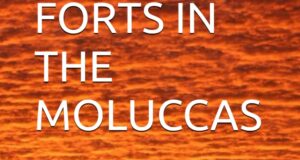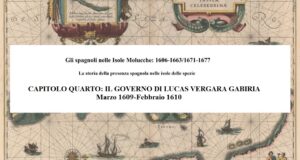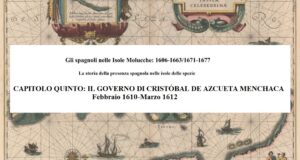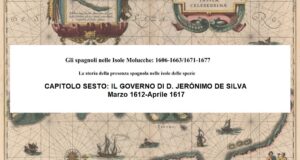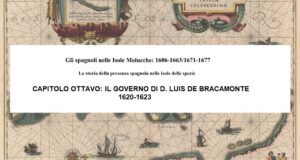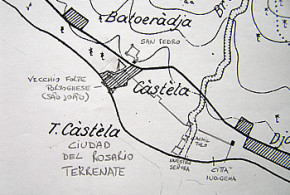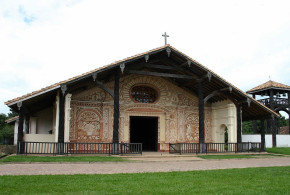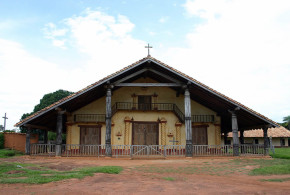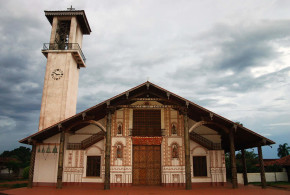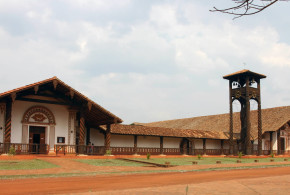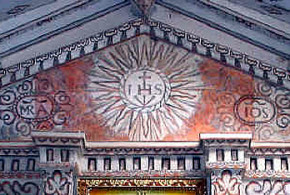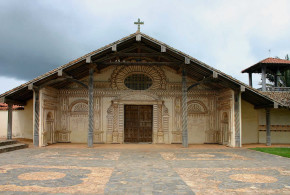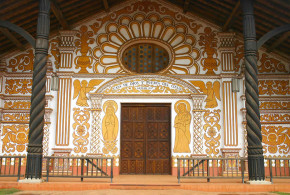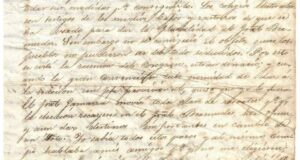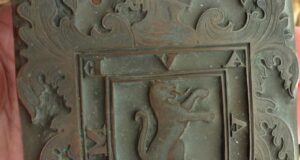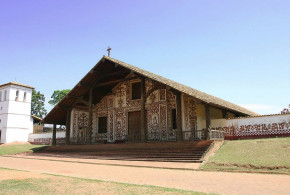This post is also available in:
![]() Italiano
Italiano
Written by Marco Ramerini 2000-2007/2023
5 – DEFENSES OF THE CITY OF THE KING
The centerpiece of Tidore’s defenses were the fortifications of the island’s main city, which the Spanish called Lugar Grande del Rey. It was located on the southeast coast of the island, where today is the main city of Tidore, Soa Siu. Over the years, a series of forts and defensive posts were built around it. During the Spanish period, the following forts and defensive structures were part of its fortifications: the Portuguese fort, the King’s fort, the Prince’s bastion and the Tahula fort. Further south was the small fortification of Socanora.
5.1 – LUGAR GRANDE DEL REY (SOA SIU) AND GOMAFO FORT:
Spanish: Lugar Grande de Tidore, Lugar Grande del Rey, Pueblo Grande de Tidore: (Current name: Soa Siu)
Spanish: Fuerte de el Rey de Tidore, Gomafo1, Samafo2
Dutch: Gomaffa3, Gamaffa4, Comaffa5
This was the main city of the whole island of Tidore, where the sultan had his residence, it was located on the southeast coast of the island on the site of the current city of Soa Siu. It was in this city that in 1521 the ships of Magellan’s expedition arrived. The Spanish were well received and an alliance was established with the Sultan of Tidore. It was precisely because of this alliance with the Spanish, in addition to the continuous state of war with Ternate which was a close ally of the Portuguese, that Tidore was often attacked and sacked by the Portuguese. Already at the end of 1526, shortly before the arrival of the Loaisa expedition, the city of the king of Tidore had been destroyed and burned by the Portuguese troops led by Garcia Anrriquez (Garcia Henriques). In the city the Portuguese captured seven pieces of artillery, probably some were those left by the Spaniards of Magellan’s expedition.6
It was here, as we have seen, that the Spanish built their first fortress in 1527. The city is described by Castanheda as a large city located a short distance from the sea and surrounded by a palisade instead of a wall ‘…cercada de hũa tranqueyra de duas faces…’. The first fortress of the Spaniards was located within the city ‘…a fortaleza dos Castelhanos que astauã dentro’.7
Subsequently, during the government of the Portuguese captain Vincente da Fonseca, the city of Tidore was again attacked and sacked by the Portuguese, the king of Tidore and his subjects took refuge on a mountain which was located above the city, it was on this mountain where the fortress of the king of Tidore was later built.8 This fortress must have been built immediately after the withdrawal of the Spanish soldiers of the expeditions of Loaisa and Saavedra Ceron, in fact the sources begin to speak of it starting from the time of the governor Antonio Galvão.
After the destruction brought by the Portuguese attacks, the king of Tidore wasted no time and prepared important defense works around his city. Around 1536, the city of Tidore is described as well fortified with walls, ramparts, ditches and palisades. It was located along the beach, where there were some well-manned bastions and artillery.9 Near the city, towards the interior, was the king’s fortress set on a cut rock, which could be reached by a narrow and steep path after a climb of more than a league.10 The fortress of the king, is described by Diogo do Couto as a ‘castello roqueiro arrezoado‘ located on top of a mountain at a certain distance from the city, but which dominated it from above.11
The fortress, which according to some witnesses was judged impregnable, was however not as fortified as it might seem at first superficial observation, it had few men in its defense and no artillery. Antonio Galvão, the Portuguese governor of Ternate, who was preparing to lead a new punitive expedition against the king of Tidore, in fact decided to attack the fortress first, thinking that once captured, the city would also be easily taken. Galvão, after some Portuguese troops with a diversionary maneuver had feigned an attempt to land in front of the city, landed at the head of 120 Portuguese soldiers in the vicinity of the rock where the fortress was and climbed towards it by a path away from the city. But the surprise effect was not successful, in fact, about half a league from the fortress, the Portuguese had a hard battle against a contingent of enemy troops led by Cachil Dayalo, fortunately for the Portuguese, the battle ended with the death of Cachil Dayalo and with the victory of the Portuguese who pursued the fleeing enemies and entered the fortress.
The fort was captured and set on fire on December 21, 1536, it burned rapidly as the houses inside were all made of wood and reeds. Then the city of the King was also completely burned, its defense works, bastions and walls, were dismantled, which was done with extreme skill, requiring a few days of work.12 Curious to note is the mention made by Galvão to the fact that the leaders of the island of Tidore could speak Portuguese, Castilian and Basque.13 Confirmation of this also comes from Castanheda who explains how the then seventeen-year-old king of Tidore, having grown up with the Spaniards, knew Castilian, Basque and Portuguese well.14
Other news on the fort of the King of Tidore comes from the expedition of Villalobos. The king of Tidore in August 1545, to better defend himself from enemies, had a dry stone fortress built on the top of a hill ‘… hizo fortalezer un peñol y ençima del hizo una fortaleza de piedra seca, para se recojer alli si neçessario fuese, …’.15 As Diogo do Couto states, this fortress was built in the same place where the previous one was destroyed by Antonio Galvão, according to Couto the Spaniards of the Villalobos expedition also participated in the construction of this fort, the fort was ‘huma fortaleza de pedra ençosso’ located on a ‘padrasto, que ficava sobre as costas da cidade’.16
The existence of this stronghold on the island of Tidore evidently greatly disturbed the Portuguese who demanded that it be immediately dismantled. In 1551, after long negotiations between the king of Tidore and Bernaldim de Sousa, the fortress of Tidore was finally dismantled ‘acabou de por tudo por tera’.17 In the following years, however, the Tidorese rebuilt their fortress, because at the time of the Dutch attack on Tidore, in 1605, the women and children of the Portuguese community residing in Tidore took refuge in the fort of the king of Tidore.
A good overview of the city of Tidore is given to us by the plate XVIII published in “India Orientalis” pars VIII, Francofurti 1607. This overview of the city of Tidore is of great help to locate the defenses of the city also during the later Spanish period. It depicts the attack and capture of the Portuguese fort of Tidore by the Dutch in May 1605. On the far right of the plate (i.e. on the north side) the Portuguese fort is depicted with the powder magazine tower in flames. The fort has a round tower on the south side of the landward facing wall, while another round tower, that of the burning powder magazine, is located along the north wall, it was here that the Portuguese made their last desperate stand. On the side of the wall facing the sea was an artillery position and a sort of bastion where the attacks of the Dutch were concentrated and where their artillery had managed to open a breach. To the south next to the fort is the Jesuit church and then the village of the Portuguese casados.
In the center of the picture is the king’s city with the mosque (the ‘Lugar Grande de el Rey‘, as the Spaniards would later call it) and the royal palace, in the background of the city is a hill with a fortified village, this is the place where the king has his fort and where the women and children of the Portuguese took refuge at the time of the Dutch attack.18 A round hill located on the sea and overlooking the king’s city from the south is the place where the Spaniards will later build their most important fortress on the island: Tahula. In the image on the tip at the foot of this hill some artillery pieces are mounted as well as along the coast in front of the king’s city, one of these two artillery positions could be the place where the so-called bulwark of the Prince will then be erected. Over the hill, further to the left (i.e. south of town) is another burning village, it could be Socanora.
The voyage report of Admiral C. Matalief (1607), contains an interesting description of the Spanish fortifications of the city of Tidore: the Dutch fleet is anchored in front of the city of Tidore, on the east coast of the island. Along the beach the Spaniards have a stone bastion whose walls are as high as a man, and a few musket shots long (a musket shot corresponds to about 250 m.) in the direction from north to south (this bastion could be the bulwark of the Prince). In the southern part there is a round mountain, difficult to access, on top of which there are Spanish soldiers and three cannons (this hill is where in the following years the Spaniards will build the fortress of Tahula). Also on the north side the city is protected, in fact at the distance of a big cannon shot (a cannon shot is approximately between 600 m. and 1000 m.) there is the old Portuguese fort. In front of the city in the sea there is a coral reef that can only be crossed at high tide, it starts from the south of the city and reaches the Portuguese fort.19
In June 1608 the Dutch, in anticipation of an attack to be carried on the city of Tidore, carried out an inspection in Tidore with a caracora and also described, among others, the fort of the king of Tidore, it is described as a fort difficult to besiege with their arms, the king could dispose according to the report of about 3000 men in arms.20 The difficulty of siege was most likely due to the fact that the King’s fort was located inland from the sea so the Dutch in the event of a siege could not rely on the superiority of the firepower of their ships.
Other subsequent documents still mention the fort of the king of Tidore: the fortress of the king of Tidore, appears to be heavily fortified, thanks to its location, but has little artillery: ‘…tres pesas de escolher e dez ou doze falcões…’. The fortress was located on a very high place and faced the Spanish fortress of Tahula. The troops available to the king of Tidore consisted of 4,000 men, including 2,000 musketeers and 2,000 ‘…campilão carrasca…’.21 Confirming the lack of artillery in the fort is the request that the king of Tidore made to Geronimo de Silva in March 1613, at the most critical moment for Tidore during the year of the great Dutch assaults, in fact the king requested the sending, of even a small caliber artillery piece for his fort.22
Some documents also tell us what was the name of the king’s fort: in November 1615 the king of Tidore asked D. Gerónimo de Silva for a stonemason to renew the bulwark of the Gomafo fort, because it had leaned to one side.23 That Gomafo was the name by which the fort of the king of Tidore was called is more clearly indicated in a letter from the governor of Ternate Gerónimo de Silva which tells of an episode that took place in 1616: the betrayal of the prince of Tidore. Out of love for the Princess of Jailolo, he had fled from the Dutch to Malayo, and it seems he had made an agreement with the Dutch to give them the fort of Gomafo. The prince then returned to Tidore attempted a coup by occupying his father’s fort of Gomafo with his own garrison, in the attempt he also broke a water cistern of the fort. After this episode, the Spaniards asked for permission to place a garrison of soldiers in the fort of Gomafo, but the request, although the king was favourable, led to a harsh reaction from the Tidorese. It appears that no Spanish garrison was placed in the fort. On this occasion, given the extreme insecurity of the situation, the old king of Tidore, Cachil Mole, was offered the possibility of residing in the Spanish fort of Tohula in the apartments of the governor.24
In April 1616, a Dutch sergeant, Arnaut de Capeu, who had escaped from the fortress of Malayo and had taken refuge with the Spaniards, declared among other things that there was a rumor in Malayo that as soon as more reinforcements reached the Dutch they would be sent to Tidore to get what the prince had promised to Governor Lorenzo Real, namely the submission of the kingdom of Tidore to the Dutch and the cession of the fortress of Samafo (Gomafo), all this in exchange for the hand of the queen of Jailolo of which he was madly in love.25
Despite these precedents, the king of Tidore managed to maintain control over the fort and Dutch attempts were thwarted. Subsequently, in 1618, following the intense fortification works carried out both in Ternate and in Tidore by Lucas de Vergara Gaviria, the whole city of Tidore was surrounded by solid walls.26 In 1634, the king of Tidore Cachil Varo (Naro), had as his principal residence his fort of Tidore, which, according to Don Juan Cerazo de Salamanca, was by far the most important fort on the island, more important even than the forts owned in the island by the Spaniards, it had under its orders a large mass of soldiers with over 2,000 men who obeyed the King.27
In 1657, during the rebellion of the Tidorese, the fort of Gomafo reappears in some Spanish documents, in fact the fort was besieged by the rebels for several months, as is clear from the memorial of Juan de Origuey: the enemies entrenched themselves within a musket shot of the fortress of ‘Domafo’ (Gomafo) which was situated in a very strategic position ‘por ser eminente alas de mas’ and being the fortress in question in grave danger, the Spaniards sent some soldiers including Juan de Origuey to reinforce the defenders of the fort, Origuey remained in defense of the fort fighting day and night. During this siege Origuey made several sorties against the enemies to get food and also defended the village of ‘Mori‘ loyal to the Spanish ‘defendio el pueblo de los moros de nuestra parcialidad‘ located under the fort, where the Spanish sent a troop of infantry to garrison the village.28 In 1658, the enemy having abandoned the trenches with which besieged the fort, a troop of soldiers attacked the enemies, putting them to flight. The siege lasted almost a year and Origuey tells us that the Spaniards suffered from hunger, having to feed on trees and wild herbs, because of these privations over 100 soldiers went over to the enemy.29
INDEX:
1 – The Spanish fortresses on the island of Tidore 1521-1663: introduction
3 – The Spanish expeditions to the Moluccas after the union with Portugal
4 – The Spanish forts of the island of Tidore 1606-1663
5 – The defenses of the city of the King of Tidore: Lugar Grande De El Rey (Soa Siu)
6 – Fuerte de los portugueses (Fortaleza dos Reis Magos)
7 – Tohula Fort, Santiago de los Caballeros
8 – Sokanora Fort
9 – Marieco Fort
10 – Tomanira Fort
11 – Chobo Fort
12 – Fort of Rume
13 – Puli Caballo Island
14 – Captains of Tidore (Fortress of Santiago de los Caballeros)
NOTES:
1Various authors “Correspondencia” 330, 374-375, 378
2 Pastells “Historia…” tomo VI, p. ccclxxxiv
3 Tiele, P. A. & Heeres, J. E. “Bouwstoffen voor de geschiedenis der Nederlanders in den Maleischen Archipel” (s’Gravenhage, 1886-1890-1895) vol. II, 382
4 Tiele, P. A. & Heeres, J. E. “Bouwstoffen…” vol. III, 382
5 Tiele, P. A. & Heeres, J. E. “Bouwstoffen…” vol. III, 400
6 Lopes de Castanheda “História do descobrimento e conquista da Índia pelos portugueses” Livro VII, cap. 39, p. 438; Gaspar Correia “Lendas da India” vol. III, 173; Diogo do Couto “Da Asia” (Lisbona, 1973) Decada IV, part 1, 176-178
7 Lopes de Castanheda “História do descobrimento e conquista da Índia pelos portugueses” Livro VIII, cap. 4, 567
8 Lopes de Castanheda “História do descobrimento e conquista da Índia pelos portugueses” Livro VIII, cap. 57, p. 660 Gaspar Correia “Lendas da India” vol. III, 492
9 Antonio Galvão “História das Molucas” (Roma, 1971) 239, 247
Diogo do Couto “Da Asia” Decada V, parte 1, 147
10 Lopes de Castanheda “História do descobrimento e conquista da Índia pelos portugueses” Livro VIII, cap. 157, 824
11 Diogo do Couto “Da Asia” Decada V, part 1, 147
12 Galvão “História das Molucas” 245, 247-255; Lopes de Castanheda “História do descobrimento e conquista da Índia pelos portugueses” Livro VIII, cap. 158, 825-828; Gaspar Correia “Lendas da India” vol. III, pp. 803-805; Diogo do Couto “Da Asia” Decada V, part 1, 147-153
13 Galvão “História das Molucas” 259
14 Lopes de Castanheda “História do descobrimento e conquista da Índia pelos portugueses” Livro VIII, cap. 37, 625
15 “Relacion de Garcia de Escalante Alvarado” AGI: Patronato,23,R.10 in: Consuelo Varela “El viaje de don Ruy López de Villalobos a las islas del Poniente, 1542-1548” (Milano, 1983) 143-144
Pastells “Historia general de las islas Filipinas, 1493-1572” vol. I, clxxvi
16 Diogo do Couto “Da Asia” Decada V, part 2, 409
17 “Fr. Juan de Beira to Fr. Simão Rodrigues, Cochin 7 de Fevereiro de 1553” in: Jacobs, “Documenta Malucensia I, 1542-1577” 120
Gabriel Rebelo “Informaçam das cousas de Maluco” in: Artur Basilio de Sá “Documentação para a historia das missões do padroado português do Oriente. Insulindia” Vol. 6, 272-276
Couto “Da Asia” Decada VI, parte 2, 366-379
18 It is certainly the same hill where the king of Tidore had a dry stone fortress built in August 1545.
19 “Report of the voyage of the admiral C. Matelief, 1607” In: Commelin “Begin ende voortgangh …” Vol. II, 63
This report must have been unknown to Admiral Paulus van Caerden since in a letter to the administrators of the VOC he complains of the poor knowledge that the Dutch had of the island of Tidore, in particular they had no information of the defenses of the capital of the island. “Copie van het scrijven van Paulus van Caerden aan de bewindhebbers dd. 17 juni 1610” In: de Booy “De derde reis van de VOC naar Oost-Indië onder het beleid van admiraal Paulus van Caerden uitgezeild in 1606” vol. II, 239
20 “Informatie van den stant van de Molucques, door Jan Bruyn, 12 may 1609” In: Opstall, M. E. “De reis van de vloot van Pieter Willemsz Verhoeff naar Azie, 1607-1612” (‘s-Gravenhage, 1972) vol. II, 304
21 “Relação breve da ilha de Ternate, Tydore…, Malaca, 28 novembre 1619” In: Various authors “Doc. Ultramarina Portuguesa” vol. I, 168
Rios Coronel, Hernando de los “Memorial y relacion… 1621” In: Blair, E. H. e Robertson, J. A. “The Philippine Islands, 1493-1898” vol. 19 (1620-1621), 288
22 “Carta que escribió el rey de Tidore á el gobernador don Gerónimo de Silva, Tidore, 30 de marzo de 1613” In: Various authors “Correspondencia” 93
23 “Tanto de carta que el rey de Tidore escribió á el gobernador don Gerónimo de Silva, Tidore en 18 de noviembre de 1615” in: Various authors “Correspondencia” 330
24 “Tanto de carta que el señor gobernador don Gerónimo de Silva escribió á el señor don Juan de Silva de comun acuerdo y consejo de los capitanes, desde Tidore en 25 de junio de 1616” In: Various authors “Correspondencia” 374-375, 378
25 Colin-Pastells “Labor Evangelica” vol. III, 628-631 note n°1 e 328-329
Pastells “Historia general de Filipinas” Tomo VI (1608-1618) ccclxxix-ccclxxxiv
“Traslado de las declareciones de Arnaut Lapen, holandés huído de los corsarios ante el capitán Alonso Martín Quirante el 28 de abril de 1616: que los navíos holandeses llegados al Malayo eran seis, y que vinieron por el estrecho de Magallanes al mando del general Jorge de Espelbergue (sic). Manila, 10 de noviembre de 1616” in: “Informaciones sobre los corsarios holandeses, 1616[Probable]” AGI: Filipinas,37,N.19
26 “Carta de Manuel Ribeiro a Fajardo de Tenza sobre Terrenate, 10-08-1618” AGI: Filipinas,7,R.5,N.54
Pubblicata anche in: Jacobs, H.“Documenta Malucensia III, 1606-1682” Doc. n° 106, 375-378 e in Blair, E. H. e Robertson, J. A. “The Philippine Islands, 1493-1898” vol. 18, 137-140.
“Traslado de una carta del rey de Tidore, al gobernador de Filipinas, comunicando lo que supone para estas islas la pérdida de la armada y pidiendo le envíen algunas galeras para no interrumpir la comunicación entre las islas del Maluco, Tidore 17 de mayo de 1618” In: “Carta de Alonso Fajardo de Tenza sobre asuntos de gobierno, 10-08-1618” AGI: Filipinas,7,R.5,N.53
27 “Letter by Don Juan Cerazo de Salamanca to Felipe IV, 10 august 1634” published in: Blair, E. H. e Robertson, J. A. “The Philippine Islands, 1493-1898” vol. 24, 330-334
28 “Memorial of the ensign Juan de Origuey” (Manila, 20 September 1673) (sheets 18-20) in: “Confirmación de encomienda de Batangas. Expediente de confirmación de la encomienda de Batangas en Balayan a Lorenzo de Zuleta. Resuelto. [f] 03-04-1677” AGI: Filipinas,54,N.14
29 “Confirmación de encomienda de Majayjay, etc. Expediente de confirmacion de las encomiendas de Majayjay y Santa Cruz en La Laguna de Bay a Juan Rodríguez de Origuey. Resuelto[f]. 08-06-1695” AGI: Filipinas,58,N.3
This post is also available in:
![]() Italiano
Italiano
 Colonial Voyage The website dedicated to the Colonial History
Colonial Voyage The website dedicated to the Colonial History


